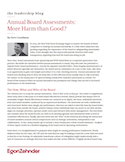In 2003, the New York Stock Exchange began to require the boards of listed companies to undergo an annual assessment. At a time when awareness was growing regarding the importance of the board in safeguarding shareholder value, it was thought that this step would provide investors with some transparency regarding how well the board was doing its job.
Since then, board assessments have spread beyond NYSE-listed firms as a corporate governance best practice. But while the intention behind annual assessments is sound, they also have the potential to impede better board performance—exactly the opposite intended effect. These lengthy questionnaires, in which directors typically rate themselves, the board and its committees on a one-to-five scale, take what is an opportunity to gain real insight and reduce it to a box-checking exercise. Annual assessments lull boards into thinking they’ve done the deep dive of self-reflection when usually they’ve only scratched the surface. In the many years I’ve spent working closely with chairmen and boards as a whole, I’ve heard of few instances when an annual assessment has prompted real change that has led to increased performance in the boardroom.
The How, What and Who of the Board
The solution isn’t to scrap the annual assessment—they’re fine as far as they go—but rather to supplement them every three to five years or so with board effectiveness reviews, which provide that deeper level of actionable insight. Board effectiveness reviews are centered on in-depth, two-hour, individual interviews with each board member conducted by an experienced facilitator. The interviews are both confidential and structured. Rather than simply rate performance, directors are asked to describe how the board draws new ideas from outside the board, achieves balance when individuals have too much or too little airtime, aligns on strategic priorities, operates under stress and interacts with senior management. The interviews also examine what the board focuses on, both in its meeting agendas and information flows as well as committee effectiveness. Finally, directors delve into the “who” of the board by describing the interaction of board members around critical competencies such as strategic orientation, independence and collaboration. In fact, many boards opt to include a more formal peer review around behaviors. Analysis of these inputs results in a detailed mapping of the board and its operating environment.
From there, it is straightforward to pinpoint what might be causing performance bottlenecks. Poorly defined remits for the chair, the CEO and the lead director may be making it hard for a new chief executive to find his or her footing. An admirable boardroom culture of collegiality might inadvertently hide a lack of consensus on strategic direction that makes decisive action difficult. A highly involved board may be undercutting the executive committee’s growth as a team. Uncovering these issues sets the stage for facilitated discussion within the board about possible solutions and their implementation. (This paper provides a detailed discussion of the review process, along with three case studies drawn from the more than 500 board effectiveness reviews that Egon Zehnder has conducted.)
Obviously, delving into areas for improvement needs to be done with tact and diplomacy, and for that reason the initial findings are usually shared only with the board chair and the chair of the nominating committee. But I have also found that directors, almost to a person, are hungry for informed, experienced counsel that would help them to be better board members. Board effectiveness reviews can be powerful tools to provide that guidance to both individual directors and the board as a whole at a time when board performance is more important than ever.






